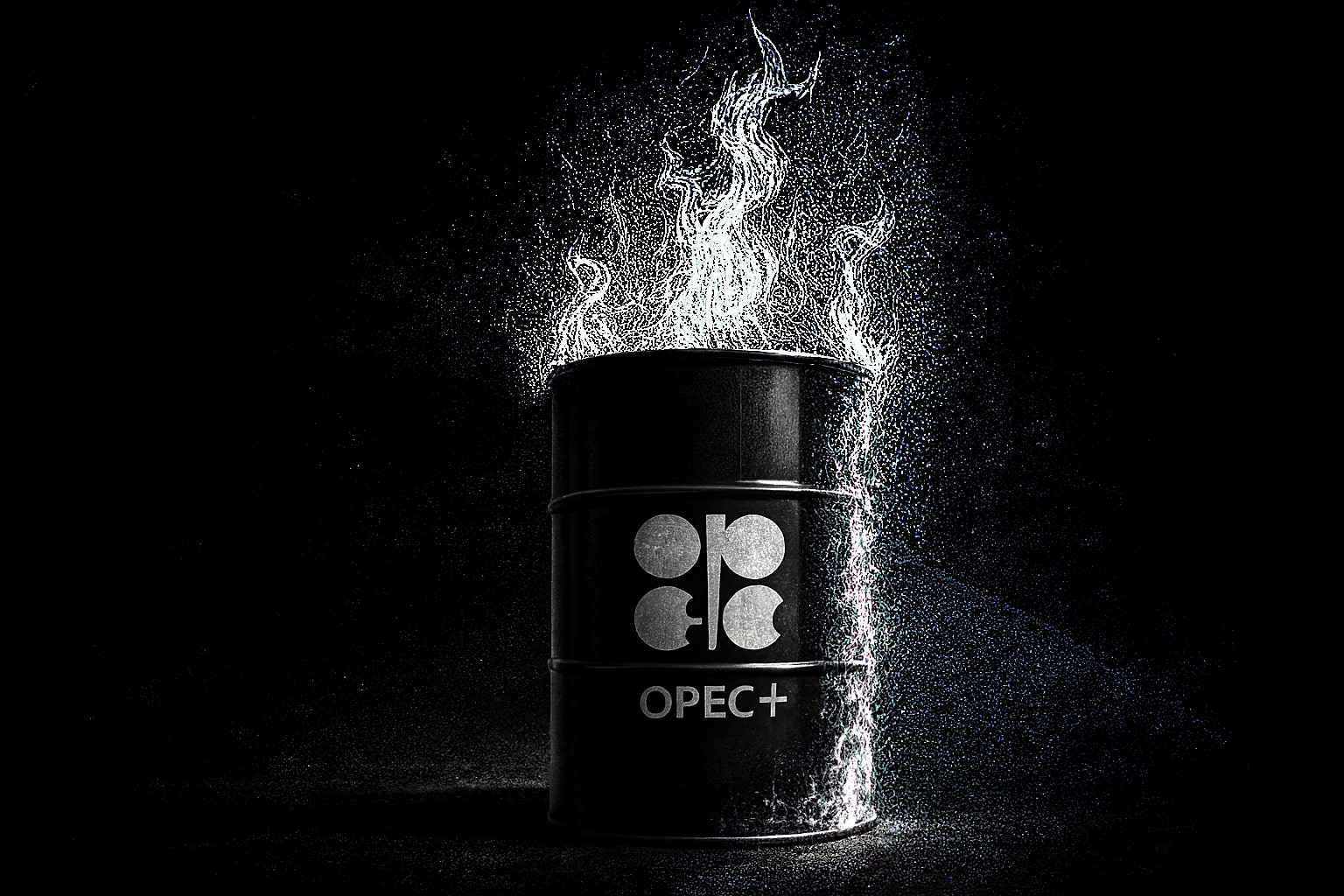Oil Snapshot: WTI (CL=F) and Brent (BZ=F) Slip Into Weekly Red Despite Tight-Supply Signals
West Texas Intermediate is pinned near $63.73, down 0.23% on the session after dipping to $62.92 earlier, while Brent trades around $66.49, marginally positive on the day but lower on the week after touching $65.92 intraday. The complex has shed more than 5% since Monday, with Murban at $68.68 (-0.77%) underscoring Middle East grade resilience relative to U.S. light sweet. U.S. blends show sharper weakness: Louisiana Light at $69.31 (-4.54% daily), Mars US at $71.56 (-1.41%), and the OPEC Basket at $69.49 (-1.56%). In products, RBOB gasoline holds at $2.082 (+0.20%), cushioning refining cracks even as Natural Gas (NG=F) slides to $2.998 (-2.25%), a notable crude–gas divergence this week.
Tariff Shock, Trade Routes, and the New Geography of Barrels
Policy risk is doing the near-term price discovery heavy lifting. The White House’s additional 25% levy on Indian goods, taking effective tariffs to 50% later this month, directly targets New Delhi’s sustained intake of Russian crude. Analysts peg the tail risk at as much as 3.5 million barrels per day of flows in play if compliance or financing channels seize up, although actual dislocation should be lower as trade re-routes. Evidence is already visible: India’s state refiners have contracted at least 22 million barrels of non-Russian crude for September–October delivery, pivoting toward West African and Middle Eastern supplies. Russia, anticipating that pivot, is offering Urals into China at softer terms—premium to Brent trimmed to $1.50 per barrel from $2.50 last week—to coax buyers who typically prefer ESPO. The immediate implication for benchmarks is two-way noise: Brent’s seaborne basket gains optionality from Atlantic Basin barrels diverted to India, while WTI’s relative softness reflects U.S. domestic balances and risk-off hedging—yet the Brent–WTI differential near $2.76 keeps export economics viable for U.S. Gulf barrels.
China’s Demand Pulse: Higher Year-on-Year, Softer Month-on-Month
China imported roughly 11.16 million barrels per day in July, up 11.5% year over year but 5.4% below June’s 12.14 million bpd spike that coincided with post-maintenance restocking and opportunistic buying of discounted cargoes. Between March and July, storage builds added roughly 80 million barrels, lifting onshore stocks toward 1.13 billion barrels. With SPR and commercial top-ups cooling, August–December imports are expected to ease toward ~11.0 million bpd, about 200,000 bpd below last year’s comparable period. That shift tightens prompt availability of sanctioned barrels but tempers outright demand growth, partly explaining why Brent (BZ=F) at $66–67 failed to extend gains even as China’s year-on-year comparisons look robust.
OPEC+ and the Supply Side: Unwinding in Slow Motion, Saudi Drilling Pulls Back
OPEC+ has been unwinding cuts more slowly than headline schedules implied, which would normally underpin backwardation; however, risk sentiment around tariffs has dominated. Saudi Arabia provides a second tightening signal: active oil rigs fell to about 20 in July from 46 in early 2024, the lowest since early-2020s troughs, while gas rigs are ramping ahead of Jafurah Phase 1. Reduced oil drilling in the world’s lowest-cost system lowers the medium-term probability of an aggressive Saudi supply swell into year-end, a supportive factor for Brent (BZ=F) once policy noise fades.
U.S. Fundamentals: Low Rigs, Fewer Frac Crews, Slight Output Dip
Baker Hughes pegs the total U.S. rig count at 539, down 49 versus a year ago. Oil rigs edged up 1 week over week to 411 but remain 74 lower year on year; gas rigs slipped to 123, down 1 on the week and up 26 versus last year. The Permian dropped three rigs to 256 this week and is 48 rigs lighter than a year earlier. Completion activity is the softer tell: Primary Vision’s frac spread count slid to 167, the fewest since 2021 and 48 below March 21, signaling a slower cadence of new well tie-ins. The latest EIA weekly shows U.S. crude output ticking down to 13.284 million bpd from 13.314 million, a 30,000 bpd slip that, while small, aligns with lower crew counts. Prices nonetheless sagged, with WTI (CL=F) fading from $64.04 around 12:45 p.m. ET to the $63.70s, highlighting macro-policy overhang overwhelming micro-tightening.
Refined Products, Cracks, and Corporate Signals
Gasoline at $2.082 per gallon held a modest bid, and U.S. refiners continue to print sturdy margins, corroborated by recent earnings beats such as Marathon’s strong refining prints. Resilient cracks historically draw incremental crude barrels even when flat price weakens, a dynamic that can cap downside in WTI (CL=F) around the low-$60s. On the corporate side, U.S. majors reported solid profitability while some European peers lagged, and Big Oil’s trading arms flagged tricky tariff-era volatility—another reminder that price action is being driven as much by policy and logistics as by pure supply–demand curves.
Russia–India–China Triangle: Discounts, Freight, and Benchmark Implications
If Indian state refiners continue curbing spot Russian purchases, freight and insurance premia on shadow-fleet routes will reshape netbacks. Russia’s move to pitch more Urals to China at a thinner premium narrows ESPO’s relative advantage and could compress regional differentials. For benchmarks, the practical read-through is Brent support on any persistent Atlantic Basin pull toward India and sporadic weakness in Dubai-linked spreads if Chinese refiners arbitrage discounted Urals. The policy wildcard—talk of a Trump–Putin meeting and separate U.S. timelines around a Ukraine ceasefire framework—adds headline volatility but does not immediately change barrels on water this month.
Technical Map: WTI (CL=F) Levels That Matter Right Now
The market is respecting the $62.90–$63.20 shelf that caught multiple intraday dips this week. Holding that area keeps a rebound toward $64.90 and $66.00 in play, with $66.50–$66.80 the first meaningful resistance zone where sellers re-emerged. A daily close below $62.80 would expose the $60.00 handle. Momentum is heavy but not capitulatory, consistent with the week’s 5% drawdown and thin August liquidity. For Brent (BZ=F), $65.70–$66.10 is the near-term pivot; above $67.20 invites a grind toward $68.50–$69.00, while a break under $65.50 risks a run at $64s.
Grade Tape and Differentials: What the Screen Is Saying About Physical Tightness
The cross-grade board shows Bonny Light at $78.62 (-2.84%), outpacing headline benchmarks as sweet Atlantic grades retain a quality premium, while Murban at $68.68 reflects steady Middle East light sweet demand into Asia. The OPEC Basket at $69.49 and Mars US at $71.56 indicate sour grades still trade with a sulfur discount but haven’t collapsed, suggesting complex refiners are continuing to bid for medium-sour barrels even as flat price wobbles. That combination—sweet premiums intact, sours stable—tends to foreshadow a floor in headline benchmarks absent a macro shock.
Macro Cross-Currents: Equities Firm, VIX Softer, Crude Lags—For Now
Equities are buoyant with the VIX around 15.76 (-4.89%), yet crude is off on the week, a disconnect highlighted by energy’s unique policy exposure. The rig and frac data argue for slower U.S. supply growth into Q4, China’s y/y import base is still firm at 11.16 million bpd even if month-on-month softened, and Saudi drilling retrenchment to 20 active oil rigs leans supportive. That fundamental mix does not square with a lasting breakdown below the low-$60s in WTI (CL=F) unless tariff escalation triggers a broader risk liquidation.
*Bias and Trade Stance for WTI (CL=F) and Brent (BZ=F)
With WTI (CL=F) near $63.73 and Brent (BZ=F) around $66.49, the balance of evidence tilts bullish on a 4–8 week horizon, with policy-driven dips framed as opportunities rather than trend breaks. Tactically, this sets up as a buy-on-weakness into $62.80–$63.20 in WTI, aiming for a recovery toward $66.80 first and $68.50 next, with a medium-term extension to $70.00–$72.00 if U.S. output remains near 13.28 million bpd and frac spreads stay sub-170. For Brent, a move through $67.20 opens $69.00 and $71.00. A weekly close below $62.50 on WTI or $65.20 on Brent would downgrade the stance to neutral. Net-net, Buy with defined risk, on the premise that drilling and completion data, Saudi rig pullback, and trade reroutes will tighten balances once tariff headlines are digested.




















